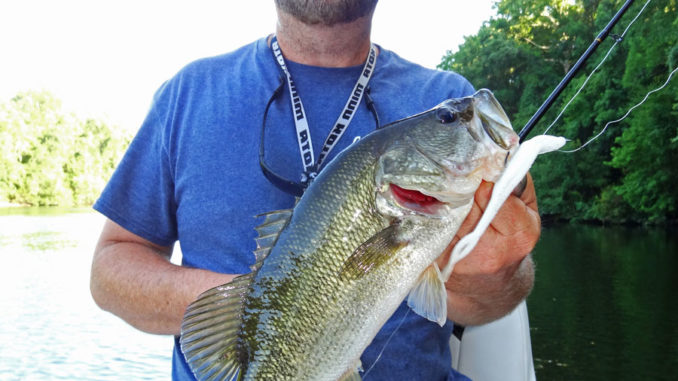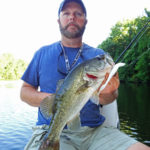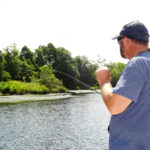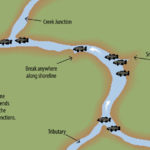
Topwaters, plastic worms are key baits for fishermen on the Santee and Cooper rivers in the fall.
September is a sensational month for an assortment of outdoor activities, but one that’s often overlooked is river fishing for largemouth bass in the coastal plain. The Santee and Cooper rivers are intertwined by their close proximity as well as sharing the bond of being sourced by Lake Marion and Lake Moultrie, but great fishing could be a strong bond.
The Santee River flows from the Wilson Dam, which impounds Lake Marion, through the Georgetown area on the way to the ocean. The Cooper River flows to the Atlantic via Charleston from the Pinopolis Dam that impounds Lake Moultrie in Moncks Corner. Both rivers have outstanding largemouth bass and not surprisingly, the action on both is white hot during September and into October.
According to angler Art Craig of Moncks Corner, fewer bass fishermen are on the rivers at this time of the year, especially during the week.
“It’s not that the fish aren’t biting like crazy,” said Craig, 50, the head football coach at Timberland High School in St. Stephens for the past 18 years, a stint that included Class 2A state championships in 2011 and 2014. “The bass action is sensational, but with so many other outdoor opportunities available as fall approaches, fishing pressure slacks a bit. Deer and dove season open, and hunting is a powerful drawing card for local outdoorsmen. But the rivers are September treasures for bass fishermen.”
“I’ve fished the rivers for about five years for both bass and bream,” Craig said. “The diversity of fishing opportunities is one of the things that make river fishing so appealing.
Another angler who runs the rivers this month is Joe Dennis, a 45-year-old resident of Bonneau who is one of only a handful of guides who fish for bass in both river systems. Dennis said comparison and contrasts between the two are interesting.
“The comparisons I’ve found work well for fishermen in that many of the basic fall tactics and patterns are the same, so lures won’t vary that much from one river to the other,” Dennis said. “Early and late in the day, the topwater action is great. I like white and pink Flukes as well as Tiny Torpedos in a black and silver shad pattern, as well as the old reliable Devils Horse in the white coach dog pattern. Also, a plastic worm rigged Texas-style is ideal for both, and I like the green shades at this time of the year.
“This works well, because it’s not all that unusual that I may fish both rivers in a day — one in the morning and one in the afternoon, depending on the patterns,” he said. “I access the Santee River from the St. Stephens area and the Cooper River from Moncks Corner, just below the dam. It’s only a few minutes from Bonneau in either direction. But excellent launching facilities exist along both rivers.”
Dennis said that the contrasts are important considerations for the two rivers.
“The Cooper River is a larger river and one that seems to always have current flow with some generation at the Pinopolis Dam,” he said. “Water movement is a dependable feature, and the amount will change and the river level will move up or down depending on outflow. But having reliable current and deeper water can be important.
“The Santee River is smaller (and) also a good bit more difficult to run in a large boat, especially in the upper end,” he said. “Near Jamestown, the Santee River opens up and is wider and deeper, but for a long stretch, it’s full of shoals, pools, rocks and blow downs. But it’s teeming with largemouth bass.
“I use my 22-foot center console on the Cooper River, but I have a shallow-draft aluminum boat ideal for the Santee River,” Dennis said. “A john boat with a small motor will work great for both rivers.”
Craig does most of his fishing on the Cooper River; his plan is to get on the water before dawn and work the shallows.
“For September fishing, look for weeds along the shoreline that are near the drop into the channel,” Craig said. “The boat may be in 15 feet of water, but the targets will be very shallow. Work a Fluke or topwater such as a Tiny Torpedo or Pop R over the grass if submerged and around the edges where the water depth abruptly drops into the river. Also, treetops and other woody debris make excellent hideouts if they’re close to the deeper water. The water temperature is still quite high in September, so most of the fish are oriented to the main river with the current flow.”
Craig said that under normal conditions, the river is fairly clear unless there’s been a lot of rainfall. Early in the morning, before sunrise, he’ll work the side of the river the sun hits first. Then, when the sun lights up that side, he’ll head to the shady size of the river.
Dennis said that mid-day does present some excellent fishing opportunities.
“Typically, I’ll have to back off into deeper water from mid-morning to late-evening,” he said. “At this time of day, I’ll use a Texas rigged plastic worm, usually a 6-inch worm with a 3/16-ounce sinker. Because this river does get a lot of pressure during the spring and summer, the smaller worms do seem to produce more bites and plenty of big bass.
“I’ll target the edge lines of big grass mats along the river, as well as the edges of rice fields with deep water nearby,” he said. “The mouths of the small creeks are excellent, as are most of the breaks or pockets with a good weed lines. Look for something different along the course of the river. A lot of the Cooper River looks good in the shallows out to where it drops into deeper water, but you can fish long stretches of good-looking water with little action. The key is to visually isolate the areas that are different so they can be targeted, and often, that’s where you’ll find the larger schools of fish.”
The Santee River may not be the typical place for a big bass rig, but it’s certainly a top bass producer, according to local experts.
Bob Matthews, a 68-year-old pastor from Ladson has a farm adjacent to the Santee River and has fished it for the past 60 years. He said the largemouth bass fishing has been better for the past couple of years than he’s seen in many years.
“The river fishing has again become very popular with fishermen, and with good reason,’ Matthews said. “The fish are not only plentiful but average very large sizes, also some of the best I’ve seen in a long time.”
Matthews said that his favorite lures have been topwaters and plastic worms.
“Fishing the river is different than fishing Lake Marion,” he said. “In the lake, the fishing can be much more complex, with deeper water, humps and ledges all holding bass at this time of year. Sonar equipment and other high-tech tools are important to success.
“On the Santee River, success depends on casting ability. You got to be able to put the lure in tight places, under limbs, around shoreline bushes and other natural objects. Depending on the water level in the river, patterns may change in terms of types of cover and depths. But it’s more of a lesson in object fishing until a pattern is determined then working that pattern.”
Matthews said one lure that’s ideal for this type situation is an unweighted plastic worm.
“White has been a very good color, but different fishermen have their own preferences,” he said. “I cast the worm around heavy shoreline cover in shallow water, and also around deeper cover in the slack water holes that may be 6 to 8 feet deep at times. I let the worm sink out of sight. I slowly twitch the lure back to the boat around, over and through cover. Fishing it too fast seems to reduce the number of bites.”
Matthews said action is better with current.
“Current enables me to get the lure in tight cover otherwise obscured by branches covering the water,” he said. “I’ll cast the lure to the edge of cover and allow it to drift downstream with the current as it falls. I don’t begin my retrieve until it gets under some bushes or heavy cover. This little trick will add some larger fish to your catch.”
Other lures will produce for different anglers, but for Matthews, other than a worm, he will use a Tiny Torpedo in frog pattern early and late in the day for topwater action.
Dennis said a lot of the fish are in the 2-pound class or smaller, but they provide almost non-stop action on catch and release.
“But plenty of bass in the 3- to 5-pound class are caught, and these larger fish certainly keep us from getting complacent, and we’re occasionally catching some really big fish,” he said. “Fast action and hefty bass make a great summertime combination.”
Dennis said he gets on the river early, just at first light, to take advantage of some sensational topwater schooling action.
“Most mornings for about an hour, the fish will be topwater schooling,” he said. “Get a lure on top of where the fish boil the surface, and odds for a hookup are great. The best lures for me have been Tiny Torpedoes and Flukes, and the best color for the Flukes has been white. Best colors for the Torpedos vary from black with white stripes to frog or shad and chartreuse. I think the most important factor is to get the lure on top of the feeding bass quickly and it triggers a bite.”
Dennis said that when the topwater action slows, the bite does not. He simply switches gears and starts working a Texas-rigged plastic worm.
“The worm can be cast in and around the logs, stumps and blowdowns on the river — or really any type object that gives a bass a good ambush point,” he said. “I’m also having a lot of success casting to the middle part of the river in deeper holes where bass congregate as the sun gets high.”
Dennis said lighter line gets more bites; he fishes 8-pound line with a 1/8-ounce slip sinker on his worm rig. His favorite colors are junebug and pumpkinseed.
“You’ll get bites on heavier line for sure, but the light line and weight does make a difference in bites,” he said. “But depending on where you’re fishing, it’s good to have a second rod rigged with slightly heavier line if you working heavy cover.”
Dennis said the Santee and Cooper rives offer great diversity in fishing style, with the common denominator of great bass fishing.
“They’re both outstanding bass factories,” he said. “They have lots of bass for fast action, and both produce quality fish. I’d give the Cooper River the edge for top-end size as the most likely to produce a double-digit sized largemouth. But the Santee will produce a lot of bass over 7 pounds and is probably pressured less because of the type of river and style of boat needed.”
A trip to either river, or both in the same day, is an option for potentially great September bass fishing. River fishing is a change of pace type fishing for many and on these dynamic rivers that change can mean catching more bass.
DESTINATION INFORMATION
HOW TO GET THERE — The Santee and Cooper rivers flow from Wilson and Pinopolis dams downstream to the coast. Boat access is somewhat limited. Pleasant Hill Landing on FS 204 F, midway between US 17 and SC 41, downstream from Jamestown, offers good access to the Santee. Bushy Park Landing in Goose Creek offers access to the lower freshwater section of the Cooper River. W.H. Dennis Landing, just downstream of the US 52 bridge on SC 402, offers access to the upper reaches of the Cooper, including the Tailrace Canal.
WHEN TO GO — Fall bass fishing can be excellent, beginning in September, and it improves as the weather cools through the fall.
BEST TECHNIQUES — Fish topwater baits early in the morning for schooling bass on both rivers. Flukes, Tiny Torpedos and Pop-Rs are preferred. Texas-rigged plastic worms fished around shoreline cover and pier, dock and bridge pilings are also very productive throughout the day.
FISHING INFO/GUIDES — Joe Dennis, Bonneau, 843-245-3762; Angler’s Sporting Goods, Moncks Corner, 843-761-1171, www.anglersportinggoods.com. See also Guides and Charters in Classifieds.
ACCOMMODATIONS — Santee Cooper Country, 803-854-2131, www.santeecoopercountry.org; Berkeley Chamber of Commerce, 800-882-0337, www.visitberkeleycounty.com.
MAPS — DeLorme’s S.C. Atlas and Gazetteer, 800-561-5105 www.delorme.com.







